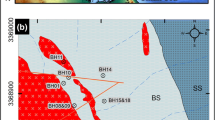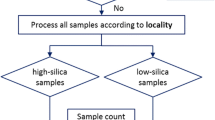Abstract
Multiple discriminant analysis is used to identify systematic variations of Cu, Pb, Zn, Ag, and Au grade values in the Canadian massive sulfide deposits with the three geological parameters of age, environment, and composition of volcanic lithology. The deposits have been separated into three groups on each of the three parameter scales and discriminant functions that separated the three groups on the basis of metal grades were then obtained. The results of the analysis indicated that Pb and Cu are the most significant in indicating specific trends along the three geological parameter scales. Pb grade increases in younger deposits with an increase in the sedimentary character of their environments, or with a more felsic nature to their volcanic rocks. On the other hand, Cu grade increases in deposits that occur in volcanic environments and with a more mafic nature to the volcanic host rocks. The results could have useful applications in mineral exploration.
Similar content being viewed by others
References
Agterberg, F. P., 1977, Frequency distributions and spatial variability of geological variables: Proc. 14th Int. Symp. Computers in Mineral Industries, p. 287–298.
Agterberg, F. P., Chung, C. F., Fabbri, A. G., Kelly, A. M., and Springer, J. S., 1972, Geomathematical evaluation of copper and zinc potential in the Abitibi area of the Canadian Shield: Geol. Surv. Canada, Paper 71-41, 55 p.
Agterberg, F. P. and Divi, S. R., 1978, A statistical model for the distribution of copper, lead and zinc in the Canadian Appalachian region: Econ. Geol., v. 73, p. 230–245.
Agterberg, F. P. and Fabbri, A. G., 1978, Spatial correlation of stratigraphic units quantified from geological maps: Comput. Geosci., v. 4, p. 285–294.
Anderson, T. W., 1958, An introduction to multivariate statistical analysis: John Wiley & Sons, New York, 374 p.
Canadian Mines Handbook, 1976–1977, Northern Miner Press, Toronto, Ontario, 1976.
Chung, C. F., 1977, An application of discriminant analysis for evaluation of mineral potential: Proc. 14th Int. Symp. Computers in Mineral Industries, p. 299–311.
Chung, C. F., 1978, Computer program for the logistic model to estimate the probability of occurrence of discrete events: Geol. Surv. Canada, Paper 78-11, 23 p.
Cooley, W. W. and Lohnes, P. R., 1971, Multivariate data analysis: John Wiley & Sons, New York, 364 p.
Fox, J. S., 1976, Some comments on the volcanic stratigraphy and economic potential of the West Amisk Lake area, Saskatchewan: Saskatchewan Research Council, Geology Division, Circular 9.
Franklin, J. M., Kasarda, J., and Poulsen, K. H., 1975, Petrology and chemistry of the alteration zone of the Mattabi massive sulphide deposit: Econ. Geol., v. 70, p. 63–79.
Graf, J. L., Jr., 1977, Rare earth elements as hydrothermal tracers during the formation of massive sulphide deposits in volcanic rocks: Econ. Geol., v. 72, p. 527–548.
Hutchinson, R. W., 1973, Volcanogenic sulphide deposits and their metallogenic significance: Econ. Geol., v. 68, p. 1223–1246.
Klecka, W., 1976, Statistical formulas used by subprogram DISCRIMINANT, unpublished manuscript, 13 p.
Kshirsagar, A. M., 1972, Multivariate analysis: Marcel Dekker, New York, 534 p.
Nie, N. H., Hull, C. H., Jenkins, J. G., Steinbrenner, K., and Bent, D. H., 1975, SPSS statistical package for the social sciences: McGraw-Hill, New York, 675 p.
Sangster, D. F., 1977, Some grade and tonnage relationships among Canadian volcanogenic massive sulphide deposits: Geol. Surv. Canada, Paper 77-1A, p. 5–12.
Sangster, D. F. and Scott, S. D., 1976, Precambrian strata-bound massive Cu—Zn—Pb sulphide ores of North America:in Handbook of strata-bound and stratiform ore deposits, v. 5 (Wolf, K. H., ed.), Elsevier, New York, p. 129–222.
Singer, D. A., Cox, D. P., and Drew, L. J., 1975, Grade and tonnage relationships among copper deposits: U.S. Geol. Survey, Prof. Paper 907A, 11 p.
Solomon, M., 1976, “Volcanic” massive sulphide deposits and their host rocks—a review and explanation:in Handbook of strata-bound and stratiform ore deposits, v. 6 (Wolf, K. H., ed.), Elsevier, p. 21–54.
Thorpe, R. I., 1974, Relation of compositions and metal ratios of massive sulphide deposits to geological environment: Geol. Surv. Canada, paper 74-1, pt. B, p. 170.
Author information
Authors and Affiliations
Rights and permissions
About this article
Cite this article
Divi, S.R., Thorpe, R.I. & Franklin, J.M. Application of discriminant analysis to evaluate compositional controls of stratiform massive sulfide deposits in Canada. Mathematical Geology 11, 391–406 (1979). https://doi.org/10.1007/BF01029296
Received:
Revised:
Issue Date:
DOI: https://doi.org/10.1007/BF01029296




